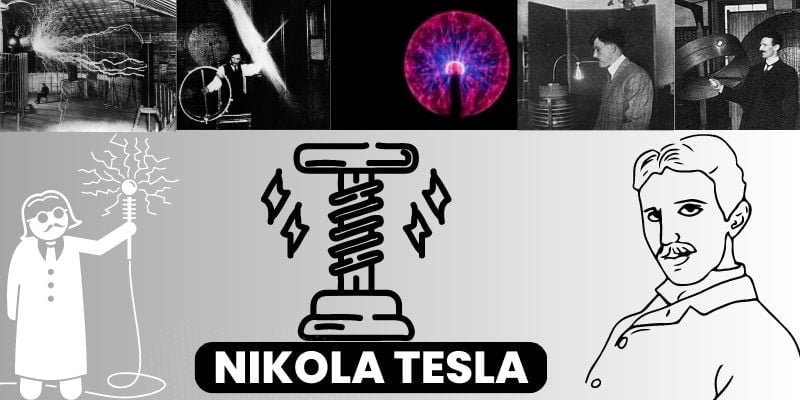The Autobiography of Nikola Tesla: The Forgotten Genius
Nikola Tesla’s life story is that of a well-renowned inventor, physicist, and electrical engineer whose groundbreaking contributions to science and technology brought a revolution to the power industry and changed the world forever. Some of his best inventions that still impact us today are the Tesla coil and the alternating current motor. However, Tesla’s life story is also filled with adventures and betrayals. Despite being one of the greatest minds of his time, he suffered from financial difficulties and mental health issues which prevented him from working on his other inventions.
Despite these challenges, Tesla’s legacy still lives on today. A unit of measurement of magnetic flux density is named after him, and there are streets, statues, and awards in his name in order to honor him. He is widely known as the man who illuminated the whole world. In this article, we will delve deep into Tesla’s life story to uncover the man behind the inventions and the struggles he faced.

Nikola Tesla Early Life:
Nikola Tesla was born to Milutin Tesla, a Serbian Orthodox priest, and Djuka Mandic, an inventor, and home-maker. On July 10, 1856, in Smiljan Croatia. Tesla was the second youngest out of five children born to Milutin. Both of his parents are highly educated and they encouraged their children to pursue science. From ripe Tesla showed immense interest and talent in mathematics and mechanics. Tesla showcased remarkable mental calculations and problem-solving without tools. His fascination with electricity ignited after witnessing a static generator in Croatian school. Nikola Tesla’s family was a well-known family in their neighborhood due to their achievements.
Nikola Tesla’s life took a dramatic turn when he enrolled as a student at the Austrian Polytechnic in Graz, Austria. He studied mathematics, physics, and mechanics at that institution. He quickly distinguished himself as an exceptional student and a brilliant inventor and engineer. In the fall of 1878, Tesla graduated from the institution with honors, and thus he began his professional career. He started as an assistant to a telegraph engineer in Budapest, Hungary.
After working in Budapest for several years, Tesla decided to move to the United States to work for Thomas Alva Edison, an inventor, and businessman. Tesla was quick to realize that Edison’s approach to inventing is flawed, Tesla was of the opinion that Edison was too focused on commercial success rather than scientific development. He decided to leave Edison and start his own laboratory in New York City in 1887.
Nikola Tesla’s Personal Life:
Nikola Tesla is known to be a man who loves his personal space. His reclusive personality and his tendency to avoid social gatherings indicate that he was an introvert. However, in certain scenarios, he would attend dinner parties hosted by his friend George Sylvester Viereck and his wife. He had a very close friendship with the renowned writer, Mark Twain, however, they seldom met. Tesla always prioritized his work over his personal relationships as he never married or engaged in romantic relationships. He was of the view that these would distract him from his valuable work.

Tesla’s work ethic was exceptionally impressive, He would often work for days without taking any break or even without sleep. In fact, He became so accustomed to working that he was only sleeping for 2 hours a day in order to accommodate his working habits. In one scenario, he would even work continuously for 84 hours without taking any breaks. However, later in life, he regretted his decision over sacrificing his personal relationships for his work.
In summary, Tesla was a solitary figure who dedicated his life to his work. Though he occasionally attended social events and had close friendships, he ultimately chose to prioritize his scientific pursuits over personal relationships. Despite this, his remarkable accomplishments and contributions to science have ensured his legacy as one of history’s greatest inventors.
Nikola Tesla Later Life:
The later part of the life of Nikola Tesla is marked by a mixture of successes and struggles. Years went by and his inventions were prolific. Despite his immense contribution to the scientific field, Tesla found himself Increasingly isolated and Financially challenged. However, in spite of these shortcomings, he was fearless and fiercely committed to his work, continuing to pursue new ideas and concepts.
Tesla made remarkable contributions to power generation and wireless communication in his last years. He developed a unique turbine engine design that he believed would revolutionize energy generation and distribution. Esla’s vision for wireless communication was truly visionary and anticipated modern technologies such as radio, television, and the internet. Overall, his legacy serves as a reminder of the power of human ingenuity and creativity.
Tesla’s Resilience: Overcoming Challenges, Inspiring Innovation, Lasting Legacy
In spite of making tremendous work in the field of science, Tesla’s later years were marked by immense struggles with finances and declining health. He suffered from several nervous breakdowns and thus became more & more isolated. Then he started spending too much time alone in his lab. He also struggled to secure funding for his research, and many of his later inventions were never fully realized due to a lack of resources.
In the twilight of his life, Tesla persevered in his pursuit of inventiveness, although his failing health necessitated a reduction in his output. At the age of 86 years old in the year 1943, he drew his last breath, but his ingenuity and resourcefulness lived on, inspiring and motivating scientists and engineers worldwide. Despite of the manifold obstacles that impeded him in his later years, Tesla’s vision of a better world remained unflagging, and his commitment to his craft serves as a model for anyone who seeks to transcend the frontiers of human knowledge and progress.
**********
Disclaimer: Views expressed are the author’s own.




